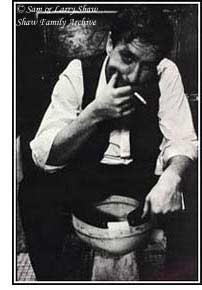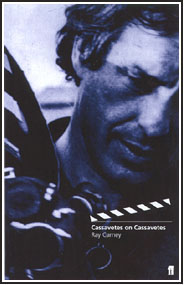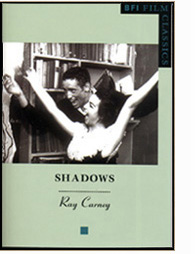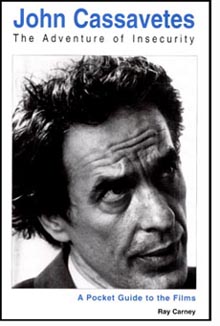|
A physicist friend
told me that there is an adage in science that you don't convert your
opponents; you wait for them to die. A discovery that is baffling or unintelligible
to one generation is accepted as obvious or even inevitable by the next.
I thought of that many times as I edited my Cassavetes on Cassavetes
(Faber and Faber/Farrar, Straus and Giroux) and Shadows (British
Film Institute Publishing).
 John
Cassavetes tells the story of his life and work in both books, based
on
interviews that I and others did with him. Part of the research involved
reading the reviews of Cassavetes' films that appeared when they were
first released in the 1960s, 1970s, and 1980s. The experience was an
eye-opener. To call them negative would be an understatement. Pauline
Kael called
Faces "dumb, crudely conceived, and badly performed;"
Variety jeered at Minnie and Moskowitz as "oppressive,"
"irritating," "shrill," "numbing," and "indulgent;"
John Simon called A Woman Under the Influence "muddle-headed,
pretentious, and interminable," and Stanley Kauffmann said it was
"utterly without interest or merit." John
Cassavetes tells the story of his life and work in both books, based
on
interviews that I and others did with him. Part of the research involved
reading the reviews of Cassavetes' films that appeared when they were
first released in the 1960s, 1970s, and 1980s. The experience was an
eye-opener. To call them negative would be an understatement. Pauline
Kael called
Faces "dumb, crudely conceived, and badly performed;"
Variety jeered at Minnie and Moskowitz as "oppressive,"
"irritating," "shrill," "numbing," and "indulgent;"
John Simon called A Woman Under the Influence "muddle-headed,
pretentious, and interminable," and Stanley Kauffmann said it was
"utterly without interest or merit."
But what became even
more striking as I reviewed the critical literature was the nearly
complete
reversal of opinion in the 12 years since the film-maker's death. The
same works that were ridiculed 40 years ago – Shadows, Faces,
A Woman Under the Influence, Opening Night and Love
Streams – are
now regarded as masterpieces. The earlier critics have not recanted,
of course; they have simply been forgotten.
Appreciation has leaped
a generation. Cassavetes exerts more influence on films and filmmakers
today than he did at any point in his own lifetime. Scores of those too
young to have seen his films when they were originally released, count
him as the patron saint of what has now come to be called the American
independent movement.
Virtually all of
the American independents of the current generation, from high-profile
figures
such as Martin Scorsese, Sean Penn and Steven Soderbergh, to younger
or less well-known artists, including Tom Noonan, Rick Schmidt, Jim
McKay,
and Caveh Zahedi, give Cassavetes credit for inspiring them to become
filmmakers. He showed them it could be done – without a
studio, a professional crew, or a multi-million dollar budget.
How could critical
judgment have been so mistaken during Cassavetes' lifetime? I think the
answer resides in the fact that he subscribed to conceptions of film-making
that even now are still fairly alien to American critics and viewers.
(Among later generation critics, David Denby is still unconvinced that
Cassavetes' work merits attention.)
 To
start with, his films were attempts to understand ordinary, everyday life.
Cassavetes' films ask questions about his experiences, and ask his viewers
to explore their own experiences. This is not unusual in other arts; it's
what poems, novels, and paintings regularly do. But exploring your own
personal experience was something American directors didn't do. They told
stories. They made "entertainment" that took people away from
their problems. Cassavetes wasn't interested in running a circus. And,
of course, the result was incomprehension from studio heads, producers,
distributors, viewers and critics fighting to hold on to their old-fashioned
notions of movies as an escape from life. To
start with, his films were attempts to understand ordinary, everyday life.
Cassavetes' films ask questions about his experiences, and ask his viewers
to explore their own experiences. This is not unusual in other arts; it's
what poems, novels, and paintings regularly do. But exploring your own
personal experience was something American directors didn't do. They told
stories. They made "entertainment" that took people away from
their problems. Cassavetes wasn't interested in running a circus. And,
of course, the result was incomprehension from studio heads, producers,
distributors, viewers and critics fighting to hold on to their old-fashioned
notions of movies as an escape from life.
While Hollywood in
the 1960s and 1970s was addicted to glamour and spectacle, Cassavetes'
films were quarried from the most ordinary aspects of his life. He is
in his movies in scene after scene, character after character.
His first film, Shadows, uses an interracial situation to explore
his own feelings of being an outsider at the social circles he was thrust
into as a young actor. More specifically, the relationship between two
of the main characters, the brothers Hugh and Ben, is a point-for-point
portrait of Cassavetes' relationship with his older brother, Nick.
Faces, the
film he made in his late thirties, depicted his fears of encroaching middle-age
and his frustrations with his marriage as well as his dreams of wiping
the slate clean and making a fresh go of it (even as he despaired that
such a fresh start could be possible).
The
opinion of Xan Cassavetes, John Cassavetes' daughter and
the director of Z Channel and other works, about Ray
Carney's Cassavetes on Cassavetes, as relayed to Carney
by a friend in Los Angeles (stars indicate omitted personal
material):
"I
am still in LA, working on *** , which is coming along. Real
progress. This evening saw Z CHANNEL, a new documentary
by Xan Cassavetes. *** I spoke with her after the screening.
I thought you might like to know that she absolutely loves CASS
ON CASS. Says she sleeps with it. Says it's enabled her
to have conversations with her father she never had."
|
Both Minnie and
Moskowitz and A Woman Under the Influence were portraits of
the filmmaker's stormy, argumentative relationship with his wife, Gena
Rowlands, and of the enormous differences in their personalities and attitudes
towards life (though Cassavetes throws viewers off the track with a gender
reversal in the later film, by having the cautious and conservative Rowlands
depicted in the character played by Peter Falk, while Cassavetes' own
feelings about life are depicted in the Rowlands character).
 The
films make no concession to easy understanding. Cassavetes' work is not
organized around traditional melodramatic conflicts between good and bad
characters, or in a conventional, problem-solving format. The only problem
that Cassavetes' characters have is what they are, and there is no solution
for that. Everyone in his films, like everyone in life outside the movies,
is both good and bad. There are no absolutes and no simple answers. There
is no narrative key to unlock the characters' hearts or solve their problems.
Life is forever lived in an uncertain, ambiguous, in-between place. The
films make no concession to easy understanding. Cassavetes' work is not
organized around traditional melodramatic conflicts between good and bad
characters, or in a conventional, problem-solving format. The only problem
that Cassavetes' characters have is what they are, and there is no solution
for that. Everyone in his films, like everyone in life outside the movies,
is both good and bad. There are no absolutes and no simple answers. There
is no narrative key to unlock the characters' hearts or solve their problems.
Life is forever lived in an uncertain, ambiguous, in-between place.
Cassavetes was the
poet of imperfection. He pioneered a radically de-idealized art form liberated
from unearthly ideals of beauty, heroism or virtue.
No cinematic works
more thoroughly embodied Lenny Bruce's statement that "truth is what
is, not what should be." Even the best of Cassavetes' characters
are bundles of flaws and foibles; even the worst surprise us with their
wit or have redeeming qualities. The result is figures that viewers can't
put handles on and pick up in a single thought.
We encounter the
characters in Cassavetes' films the way we encounter people in the
world – studying
ambiguous expressions and contradictory or inconsistent behavior, formulating
a succession of interpretive hypotheses, changing our minds as we
go along.
But what baffled
Kael, Simon, Kauffmann, and the rest of the first generation of critics
most
was that no matter how deeply flawed the characters might be, they are
not judged, but accepted and even loved – faults and all. When
asked during press screenings about his apparent failure to condemn
the male figures
in both Faces and Husbands, Cassavetes compounded the felony
by telling the critics that the main characters in those films were not
being satirized. They were not someone else. They were him
and his friends.
While most American
films of the era were in love with visual and acoustic virtuosity, Cassavetes
made movies that were calculatedly rough. He scorned beautiful shots,
favoring shifting, asymmetrical groupings that look haphazard. He said
he wanted to make movies that didn't feel like movies, but like life.
Cassavetes doesn't
employ the bouncy editing and accelerated rhythms of conventional film,
because they tell lies about the rhythms of experience outside of the
movies. The pacing of the experience is closer to that of life than of
movies. He doesn't want scenes or pacings to fall into predictable patterns.
Predictability is death. Consistency was something for robots, not human
beings. Patterns were the enemy.
 The
irony, of course, was that Cassavetes succeeded so well at capturing the
unidealized, clumsy complexities of unpatterned life that many of the
first generation of reviewers decided that the films were improvised.
In other words, those who wanted their movies to look like movies concluded
that his weren't really movies. The
irony, of course, was that Cassavetes succeeded so well at capturing the
unidealized, clumsy complexities of unpatterned life that many of the
first generation of reviewers decided that the films were improvised.
In other words, those who wanted their movies to look like movies concluded
that his weren't really movies.
Cassavetes
fulfilled Marshall McLuhan's observation that new systems of knowledge
don't look like improvements or innovations when they are first proposed.
They look like chaos. It also supported Clement Greenberg's epigram that
all profoundly original art looks ugly at first. I remember the filmmaker
joking about the reception of his work. He imitated an imaginary viewer
by slouching down in his chair and windmilling his arms in front of his
face, chortling: "A new experience? Oh, no! Save me. Anything but that!"
I was a slow learner
myself. I fought the experiences in Cassavetes' movies tooth and nail
before I could come to grips with them. There is no doubt in my mind,
at this point, that he was one of the greatest artists in the history
of film. But it's not something someone can decide for others. Kael,
Kauffmann, and the other early critics need to see the films again,
put their preconceptions
aside, and wrestle with what they actually offer. I hope my publication
of Cassavetes' own accounts of what he was trying to do with his life
and work present a opportunity for every viewer to revisit the films
and decide for himself.
Ray Carney is
the author of three new books about Cassavetes: Cassavetes on
Cassavetes
from Faber and Faber, and the volume on Shadows for the British
Film Institute Film Classics series, and the souvenir program John
Cassavetes: The Adventure of Insecurity – A Pocket Guide
to the Films.
He is Director of Film Studies at Boston University.
This
page only contains excerpts and selected passages from Ray Carney's writing
about John Cassavetes. To obtain the complete text as well as the complete
texts of many pieces about Cassavetes that are not included on the web
site, click
here.
|









